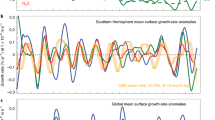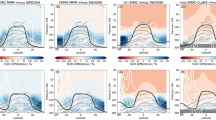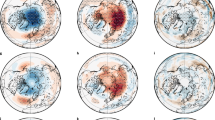Abstract
MANY recent studies have reported an apparent correlation between solar activity and the Earth's climate on the timescale of the 11-year solar cycle1–4 and over longer periods5–10, but to date no physical mechanism has been proposed that can satisfactorily explain the observations. In general, it has been assumed that changes in total solar irradiance outside the atmosphere will be reflected in proportionately equal changes at the tropopause (from where the influence on climate is determined). Here I present results from a two-dimensional radiative-chemical-transport model which show that the spectral composition of the solar variations and the photochemical production of stratospheric ozone together lead to a highly nonlinear relationship between the extraterrestrial and cross-tropopause solar radiative flux. Because of this relationship, at middle to high latitudes in the winter hemisphere less solar radiation reaches the troposphere during periods of higher solar activity. The consequent change in latitudinal temperature gradient also affects infrared radiative forcing and potentially planetary-wave activity. The general mechanism proposed here may explain some features of the observed correlations between solar variability and climate.
This is a preview of subscription content, access via your institution
Access options
Subscribe to this journal
Receive 51 print issues and online access
$199.00 per year
only $3.90 per issue
Buy this article
- Purchase on Springer Link
- Instant access to full article PDF
Prices may be subject to local taxes which are calculated during checkout
Similar content being viewed by others
References
Labitzke, K. Geophys. Res. Lett. 14, 535–537 (1987).
Labitzke, K. & Van Loon, H. J. Clim. 2, 554–565 (1989).
Van Loon, H. & Labitzke, H. J. Clim. 3, 827–837 (1990).
Labitzke, K. & Van Loon, H. Ann. Geophys. 11, 1084–1094 (1993).
Reid, G. C. J. geophys. Res. 96, 2835–2844 (1991).
Friis-Christensen, E. & Lassen, K. Science 254, 698–700 (1991).
Lean, J., Skumanich, A. & White, O. Geophys. Res. Lett. 19, 1591–1594 (1992).
Kelly, P. M. & Wigley, T. M. L. Nature 347, 460–462 (1990).
Kelly, P. M. & Wigley, T. M. L. Nature 360, 328–330 (1992).
Schlesinger, M. E. & Ramankutty, N. Nature 360, 330–333 (1992).
Penner, J. E. & Chang, J. S. Geophys. Res. Lett. 5, 817–820 (1978).
Brasseur, G. & Simon, P. C. J. geophys. Res. 86, 7343–7362 (1981).
Garcia, R., Solomon, S., Roble, G. R. & Rusch, D. W. Planet. Space Sci. 32, 411–423 (1984).
Hood, L. L. J. geophys. Res. 91, 5264–5276 (1986).
Chandra, S. Geophys. Res. Lett. 18, 837–840 (1991).
Wuebbles, D. J., Kinnison, D. E., Grant, K. E. & Lean, J. J. Geomagn. Geoelect. 43 (suppl. p 22), 709–718 (1991).
Kodera, K., Chiba, M. & Shibata, K. Geophys. Res. Lett. 18, 1209–1212 (1991).
Huang, T. Y. W. & Brasseur, G. P. J. geophys. Res. 98, 20413–20427 (1993).
Heath, D. F. & Schlesinger, B. M. J. geophys. Res. 91, 8672–8682 (1986).
Lean, J. Science 244, 197–200 (1989).
Cebula, R.P., DeLand, M. T. & Schlesinger, B. M. J. geophys. Res. 97, 11613–11620 (1992).
Hansen, J. E. & Lacis, A. A. Nature 346, 713–719 (1990).
Wigley, T. M. L. & Raper, S. C. B. Geophys. Res. Lett. 17, 2169–2172 (1990).
Harwood, R. S. & Pyle, J. A. Q. Jl R. met. Soc. 101, 723–748 (1975).
Law, K. S. & Pyle, J. A. J. geophys. Res. 98, 18377–18400 (1993).
Atmospheric Ozone 1985 (Report No. 16, World Meteorological Organisation, Geneva, Switzerland, 1986).
Lean, J. Rev. Geophys. 29, 505–535 (1991).
Willson, R. C. & Hudson, H. S. Nature 332, 810–812 (1988).
Shine, K. P., Derwent, R. G., Wuebbles, D. J. & Morcrette, J.-J. in Climate Change: The IPCC Scientific Assessment (eds Houghton, J. T. et al.) 41–68 (Cambridge Univ. Press, 1990).
Kodera, K. Geophys. Res. Lett. 18, 1023–1026 (1991).
Ramaswamy, V., Schwarzkopf, M. D. & Shine, K. P. Nature 355, 810–812 (1992).
Author information
Authors and Affiliations
Rights and permissions
About this article
Cite this article
Haigh, J. The role of stratospheric ozone in modulating the solar radiative forcing of climate. Nature 370, 544–546 (1994). https://doi.org/10.1038/370544a0
Received:
Accepted:
Issue Date:
DOI: https://doi.org/10.1038/370544a0
Comments
By submitting a comment you agree to abide by our Terms and Community Guidelines. If you find something abusive or that does not comply with our terms or guidelines please flag it as inappropriate.



